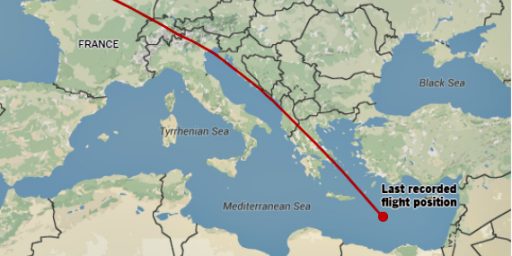Search For Flight MH370 Officially Comes To An End
The mystery of what happened aboard Malaysian Airlines Flight 370 may remain at the bottom of the Indian Ocean forever.
It’s been nearly three years since Malaysian Airlines Flight 370 left Kuala Lampur, Malaysia, only to disappear just as the plane was supposed to enter Chinese airspace. For months that followed, the saga of the missing plane became something of a worldwide obsession, with American cable news networks such as CNN devoting endless hours to breathless coverage of every little development and rumor surrounding the plane’s fate and whereabouts, often in moments that devolved into the absurd. Now, it appears, with only tangential evidence having been found that suggests strongly that the plane went down somewhere over the Indian Ocean, well off-course from the route it should have been on, the search is largely coming to an end and the mystery of what happened to MH370 remains unsolved:
SYDNEY — Australia’s Transport Minister Darren Chester said on Wednesday that experts will continue analyzing data and scrutinizing debris washing ashore from Malaysia Airlines Flight 370 in a bid to narrow down where it crashed in the southern Indian Ocean. But Chester declined to specify what kind of breakthrough would convince officials to resume the search for the missing airliner that was suspended this week after almost three years.
“When we get some information or data or a breakthrough that leads us to a specific location, the experts will know it when they see it,” he told reporters in the southern city of Melbourne.
The sonar seabed search ended on Tuesday, possibly forever — not because investigators have run out of leads, but because the countries involved in the expensive and vast deep-sea hunt have shown no appetite for opening another big phase.
Late last year, as ships with high-tech search equipment covered the last strips of the 120,000-square kilometer (46,000-square mile) search zone west of Australia, experts concluded they had been looking in the wrong place and should have been searching a smaller area immediately to the north. But by then, $160 million had already been spent by Malaysia, Australia and China, who had previously agreed not to search elsewhere without pinpoint evidence of the plane’s location. More than half of those aboard the plane were Chinese.
Since no technology currently exists that can tell investigators exactly where the plane is, that means the most expensive, complex search in aviation history is over, barring a change of heart from the three countries.
Chester defended the decision to call off the hunt without checking the new area to the north, saying, “No one is coming to me as minister and saying, ‘We know where MH370 is.'” And he insisted the enormous cost had nothing to do with pulling the plug.
“It is a costly exercise, but it hasn’t been the factor which led to the decision to suspend the search,” Chester said. “We don’t want to provide false hope to the families and friends. We need to have credible new evidence leading to a specific location before we would be reasonably considering future search efforts.”
The new 25,000-square kilometer (9,700-square mile) area to the north was determined with the help of drift modeling by Australia’s Commonwealth Scientific and Industrial Research Organization, which attempted to calculate where debris that has washed ashore on coastlines in the western Indian Ocean originated. Chester said that drift modeling would continue, and experts will scrutinize any further debris that washes up. Investigators will also continue to refine the satellite data that led them to conclude the plane went down somewhere in the Indian Ocean.
Many relatives of those lost on the plane, which vanished on March 8, 2014, during a flight from Kuala Lumpur to Beijing with 239 people on board, responded to the announcement that the search was over with outrage. A support group, Voice 370, issued a statement saying that extending the search is “an inescapable duty owed to the flying public.”
Without understanding what happened to the plane, there’s a “good chance that this could happen in the future,” said K.S. Narendran, a member of the group.
Australian Prime Minister Malcolm Turnbull said he empathized with the families, but said search officials had done the best they could under extraordinary circumstances.
“We share their deep disappointment that the plane has not been found,” Turnbull told reporters. “It is an unprecedented search. It’s been conducted with the best advice over the areas that were identified as the most likely to find the location of the airplane. It is a shocking tragedy and we grieve and we deeply regret the loss and we deeply regret that the plane has not been found.”
Investigators have been stymied again and again in their efforts to find the aircraft. Hopes were repeatedly raised and smashed by false leads: Underwater signals wrongly thought to be emanating from the plane’s black boxes. Possible debris fields that turned out to be sea trash. Oil slicks that contained no jet fuel. A large object detected on the seafloor that was just an old shipwreck.
In the absence of solid leads, investigators relied largely on an analysis of transmissions between the plane and a satellite to narrow down where in the world the jet ended up — a technique never previously used to find an aircraft.
Based on the transmissions, they narrowed down the possible crash zone to a vast arc of ocean slicing across the Southern Hemisphere. Even then, the search zone was enormous and located in one of the most remote patches of water on Earth — 1,800 kilometers (1,100 miles) off Australia’s west coast. Much of the seabed had never even been mapped.
For years, crews on several ships used sonar equipment to painstakingly comb the search area. The search zone shifted multiple times as investigators refined their analysis, all to no avail. Some began to question whether the plane had gone down in the Southern Hemisphere at all.
Then, in July 2015, came the first proof that the plane was indeed in the Indian Ocean: A wing flap from the aircraft was found on Reunion Island, east of Madagascar. More than 20 pieces of debris confirmed or believed likely to have come from the aircraft have since washed ashore. But while the debris proved the plane went down in the Indian Ocean, the location of the main underwater wreckage — and its crucial black box data recorders — remains stubbornly elusive.
If the plane is never found, the reasons for its disappearance and crash will probably never be known, though Malaysia has said the plane’s erratic movements after takeoff were consistent with deliberate actions.
Given the fact that three years of searching has produced no reliable leads on the whereabouts of the plane, and the fact that the depths to which the plane’s debris likely plummeted are well beyond the capabilities of most search equipment, this seems like an entirely reasonable decision to me. As it stands, we do know that the debris that has washed up on the shores of several islands in the Indian Ocean and the east coast of Africa belonged to a Boeing 777 and that there is no record of any other such plane either losing parts over the Indian Ocean or crashing into it, the rational supposition is that those parts came from the missing plane. Additionally, it has been confirmed that at least a handful of the debris that has washed ashore included serial numbers matching equipment such as wing flaps and engine parts that were installed on that particular plane. Taking those two pieces of evidence together, the only rational conclusion at this point is that the plane went down over the Indian Ocean and that its debris now sits on the ocean floor, possibly at depths exceeding 10,000 feet. Unfortunately, since this exceeds the levels at which most search and recovery equipment can operate, it means that investigators would likely to be unable to recover significant portions of the debris that would be necessary to try to understand why it went missing. For now at least, that means the reasons for the plane’s disappearance will remain a mystery.
The inability to discover the reasons why MH370 went down are somewhat concerning, of course. If the cause was some kind of defect in the 777, it would have been helpful to know this so that future tragedies could be avoided. If it wasn’t a problem with the plane, then the next most likely explanation is that it was a deliberate act and that the plane was taken off-course by the pilot or another member of the flight crew as part of either a suicide or an act of terrorism. In that regard, the fact that there has never been a claim of responsibility made by any terrorist organization suggests that it was unlikely that it was part of a planned terrorist operation. This leaves the last possibility as the most likely one other than some mechanical or technological problem on the airplane, namely that either the pilot or the co-pilot deliberately changed the course of the plane. What their intention was in doing so is something we’ll probably never know, but given the tracking information we do have, it appears that after that course change the plane merely stayed on course and continued flying until it ran out of fuel. One has to wonder whether anyone on board was conscious during this whole time, and what might have been going through their mind if they were. Someday, perhaps, we’ll find out when some intrepid explorer finds the remains of the plane just like the remains of RMS Titanic were eventually found. Until then, what happened to Flight MH370 will remain a mystery.







OT…last year was the hottest year on record which, following record breaking years in 2015 and 2014, makes it 3 in a row.
https://www.giss.nasa.gov/research/news/20170118/
With Trump as President, and his administration made up of fossil fuel fiends…it’s only going to get much worse. If you have children and grand-children you should apologize to them for what we have done.
Now back to the missing airliner.
I’ve always wondered how hard it was for people to accept this plane cannot and will not be found. The world is still a vast place and we do not have eyes everywhere. I know we find comfort in our technology and science but we are not yet masters of our world. That’s a whole lotta water for a debris field to hide in. The Titanic was relatively intact compared what a plane impacting the surface of the ocean will leave; plus, we had a fairly good idea for potential locations of Titanic wreckage instead the vaguely extrapolated search area for MH370.
Some mysteries don’t get solved.
@C. Clavin: Unless you believe the Australian government should spend millions indefinitely chasing lower and lower probability possibilities, there isn’t much to be said about this. That being the case, I’ll happily run off topic with you.
It’s obvious that at some point sanity will prevail, or evidence will become overwhelming, and we will ban or heavily tax carbon extraction. The Tillersons and Kochs of the world are determined to delay that day as long as possible and get every possible kilo of carbon to market before then, no matter the consequences to the world. How does someone like Tillerson sleep at night? (Rhetorical question. One or both of motivated reasoning, money being a huge motivator), and a Randian attitude that the world will go to hell anyway and he’ll take care of himself.)
More than any other agent, I blame the Republican Party. Have we in the past had a situation in which the politicians and intellectual apparatus of the Party would simply ignore established scientific facts? The republican Party is destroying the world for campaign contributions.
Lots of questions and theories about this one. One is why the Malaysian officials did not try to call some fighter jets in to follow the jet and try to maybe get a handle on what was going on ?
All that time flying around and not one cell phone call ?
@Tyrell: I could be wrong, but I suspect that the reason for no cell phone calls is the relative paucity of cell phone towers in the middle of the ocean.
Yes, of course this is the correct action. There’s a finite limit to the expense and hubbub of actively searching. You don’t “close” a search until the subject is found; until then it is “suspended”, a word used correctly in this article but probably should have been in the headline.
“I’ve always wondered how hard it was for people to accept this plane cannot and will not be found. ” Very much so. There are plenty of searches I was on in the 90s that are still suspended.
-Electroman, Col., USAF (Retired)
-former search officer, AFRCC
-graduate, AFRCC Search Mission Course
-holder of one of only six “find” credits issued by AFRCC for a crash involving a jetliner